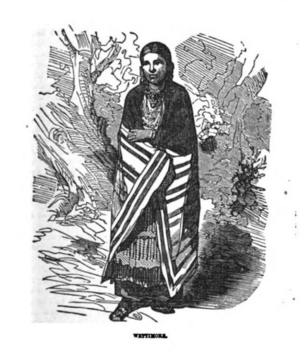Weetamoo facts for kids
Quick facts for kids
Weetamoo
|
|
|---|---|
 |
|
| Wampanoag leader | |
| In office 1675–1676 |
|
| Preceded by | Corbitant |
| Personal details | |
| Born |
Namumpum Weetamoo
1635 present day North Tiverton, Rhode Island |
| Died | August 6, 1676 (aged 40–41) Taunton, Massachusetts |
| Cause of death | Drowning |
| Spouses | Winnepurket, Wamsutta (Alexander), Quequequanachet, Petonowit, and Quinnapin |
| Parent | Corbitant (father) |
| Nicknames |
|
| Military service | |
| Battles/wars | King Philip's War |
Weetamoo (around 1635–1676) was a powerful Wampanoag leader. She was the sunksqua, or female sachem (chief), of the Pocasset tribe. This tribe lived in what is now Tiverton, Rhode Island in the 1600s.
In the Algonquian language, Weetamoo's name means "speak to them." She lived in an area now called Fall River, Massachusetts.
Contents
Early Life and Skills
Weetamoo was born in the Mattapoiset village or near the Taunton River in Rhode Island. Her father was Corbitant, the chief of the Pocasset tribe. Weetamoo was known for her artistic skills. She was very good at beadwork and quilling, which is a type of art using rolled paper or porcupine quills. She was also a talented dancer.
Marriages and Alliances
Weetamoo had five husbands during her life. Her marriages were often important for building alliances between different Native American tribes.
Her first husband, Winnepurket, was the chief of Saugus, Massachusetts. He died soon after they married.
Her second husband was Wamsutta, also known as Alexander. He was the oldest son of Massasoit, a very important Wampanoag chief who met the Pilgrims at the first Thanksgiving. Weetamoo and Wamsutta married around 1653. They may have had one child together. During their marriage, the Pocasset tribe worked with the English against the Narragansett tribe. However, the English later broke their agreements. Wamsutta became sick and died while talking with the English. His brother, Metacom (also known as Philip), became the new Wampanoag chief. Metacom's wife was Weetamoo's sister, Wootonekanuske.
Not much is known about her third husband, Quequequanachet. Her fourth husband, Petonowit, sided with the English during King Philip's War. Because of this, Weetamoo ended their marriage.
Her last husband was Quinnapin. He was a brave warrior and the son of a powerful Narragansett chief. They married in 1675. This marriage was very important because it helped make the Wampanoag and Narragansett tribes stronger together against the English colonists. Weetamoo and Quinnapin seemed to have a strong marriage and had at least one child, who died in 1676. Quinnapin was captured in 1676.
Weetamoo's Leadership
Weetamoo became the sunksqua (female chief) because her father had no sons. She was a strong leader and commanded an army of over 300 men. Being a woman did not make her less powerful among her people. Many colonists did not understand that Native American tribes could have female leaders. Some historians believe that other lesser-known chiefs might have also been female sunksquas.
In 1675, Weetamoo joined "King Philip" (Metacom) in fighting the colonists. This conflict is known as King Philip's War. Weetamoo supported Metacom by providing her soldiers to help his forces. Sadly, the English defeated the Wampanoag in August 1676.
Death
Weetamoo drowned in the Taunton River in 1676. Not much else is known about her last days or how she died. Her soldiers who were with her also disappeared.
Legacy and Recognition
Weetamoo is mentioned in a famous book called The Captivity and Restoration of Mrs. Mary Rowlandson. In 1676, Weetamoo and her relative Quinnapin attacked a colonial settlement. Mary Rowlandson was captured and held by Quinnapin for three months. She wrote about Weetamoo's appearance and personality:
A severe and proud dame she was, bestowing every day in dressing herself neat as much time as any of the gentry of the land: powdering her hair, and painting her face, going with necklaces, with jewels in her ears, and bracelets upon her hands. When she had dressed herself, her work was to make girdles of wampum and beads.
Only women of high rank were allowed to make "Girdles of wampum and beads." This shows how important Weetamoo was. Wampum belts were made from shells and used by Native Americans to send messages along with speeches.
Many places in the White Mountains of New Hampshire are named after Weetamoo. These include Weetamoo Falls, Mount Weetamoo, and the Weetamoo Trail. There is also a Six Husbands Trail, which refers to her marriages. However, there is no proof that Weetamoo ever visited the White Mountains. These names might come from a poem by John Greenleaf Whittier called "The Bridal of Penacook."
Weetamoo's teenage life is shown in the historical novel Weetamoo: Heart of the Pocasetts, which is part of The Royal Diaries series.
Weetamoo Woods Open Space in Tiverton, Rhode Island is named after her. A 50-foot boat built in 1902 was also named Weetamoo. It sailed on Lake Sunapee for 25 years before it was sunk on purpose. The Lowell YWCA Camp Weetamoo is located in Westford, Massachusetts.

